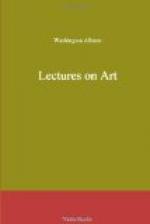Was it mere scientific curiosity that cost the elder Pliny his life? Might it not have been rather this sublime fascination? But we have repeated examples of it in our own time. Many who will read this may have been in a storm at sea. Did they never feel its sublimity while they knew their danger? We will answer for ourselves; for we have been in one, when the dismasted vessels that surrounded us permitted no mistake as to our peril; it was strongly felt, but still stronger was the sublime emotion in the awful scene. The crater of Vesuvius is even now, perhaps for the thousandth time, reflecting from its lake of fire some ghastly face, with indrawn breath and hair bristling, bent, as by fate, over its sulphurous brink.
Let us turn to Mont Blanc, that mighty pyramid of ice, in whose shadow might repose all the tombs of the Pharaohs. It rises before the traveller like the accumulating mausoleum of Europe: perhaps he looks upon it as his own before his natural time; yet he cannot away from it. A terrible charm hurries him over frightful chasms, whose blue depths seem like those of the ocean; he cuts his way up a polished precipice, shining like steel,—as elusive to the touch; he creeps slowly and warily around and beneath huge cliffs of snow; now he looks up, and sees their brows fretted by the percolating waters like a Gothic ceiling, and he fears even to whisper, lest an audible breath should awaken the avalanche: and thus he climbs and climbs, till the dizzy summit fills up his measure of fearful ecstasy.




